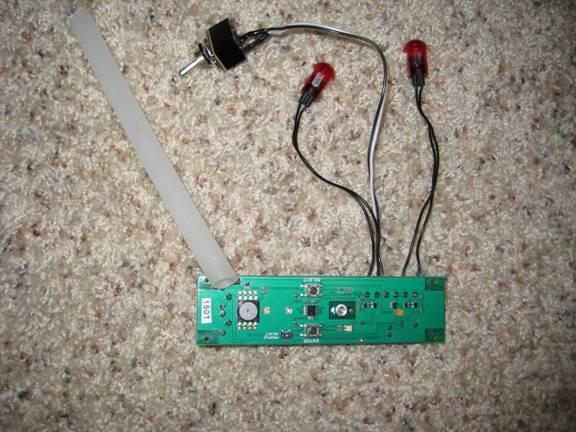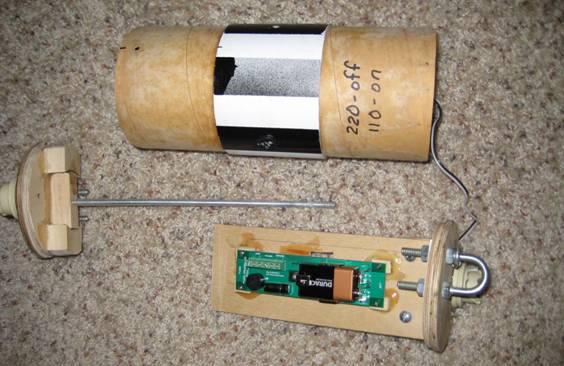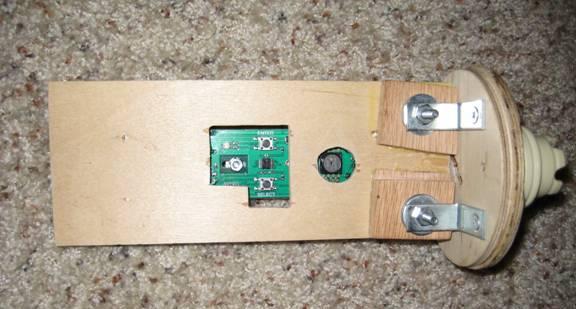| Manufacturer: | Public Missiles  |
I had the original PML Co-Pilot and flew it for several years until it went bad. I thought that I would simply replace the original Co-Pilot, but found that it had been superseded by the Co-Pilot version 2.0.
Construction:
One of the things that attracted me to the Co-Pilot version 2.0 is that the attachment holes on the electronics board are at the same location as the original. I originally had the CPR 3000 system, but had trouble with it. I decided that I would build my own electronics bay.

After looking at other designs for e-bays I would probably build a new one differently to be more versatile today, but the e-bay that I now have is durable, straightforward, and easy to use. In operation it is necessary to access both sides of the Co-Pilot. On one side are the battery and the wire attachments and on the other side are the “select” and “enter” buttons, indicator lights, and the barometric transducer. If the user employs the PML Co-Pilot holders, both sides of the unit are accessible, however, if the user mounts the Co-Pilot on his own plywood, it is possible that the backside may be inaccessible. I cut holes in the backside in order to have access to the backside of the Co-Pilot. I still use the PML charge holders on my improvised e-bay.
In some ways I liked the original Co-Pilot better, because several Dipswitches established the basic settings. The user could simply look at the Dipswitches and know the overall status of the dual deployment device. Now, there is only one Dipswitch for Profile 1 (main chute at 500’) or Profile 2 (main chute at 1000’). There are many other possible settings, which are chosen by using the “select” and “enter” button and watching the indicator lights. I think the default settings are probably appropriate for the average flight.

However, if the user inputs new settings, he may want to write down a note recording those settings. Otherwise, the user must step through the manual watching the lights to know the actual settings. If one inadvertently pushes the wrong the button the settings can be changed and will need to be rechecked.
In September 2008 when the Co-pilot first came out I found an error in the instructions. Within a week the PML service department sent me the corrections. Out of curiosity I checked this week (Oct. 2009) and asked PML if new instructions were available and one day later they emailed me the manual with the right instructions. (Their service department is always very prompt.) I suspect that this problem was corrected about a year ago and most users are not aware that there ever was a problem.
Last spring I set the Co-pilot and didn’t use it to this fall. I wanted to know if the settings were in working order without going through the entire manual. I still had test lights and an on/off switch that I bought from Radio Shack from the days when I used the original Co-pilot. These items still work for version 2 unit. I attached the test lights and the on/off switch to the Co-pilot version 2.0 and used a 1/2 “ diameter plastic tube placed over the barometric transducer. By putting one end of the tube on the transducer and sucking in air through my mouth on the other end, I was able to simulate lift-off. The Co-Pilot light quickly turned red indicating lift-off and shortly thereafter the test light for the drogue light came on followed almost immediately by the main light. This gave me confidence that the Co-Pilot would work as expected.
I launched my PML Eclipse with the Co-Pilot version 2.0 last week on a Aertoech RMS J540 and had a successful light to 4,828 feet.

Other Reviews
- Public Missiles Co-Pilot 2.0 By Don Bitz (March 26, 2009)
( Contributed - by Don Bitz - 03/26/09) Brief: I have been flying the Co-Pilot 2.0 for about six months now with no failures. I've been flying high-powered rockets for about the same length of time. Having also used several other brands of altimeters, some of which I have actually flown and others I have actually returned. For simple deployment (single or dual), I doubt there is a ...
 |
 |